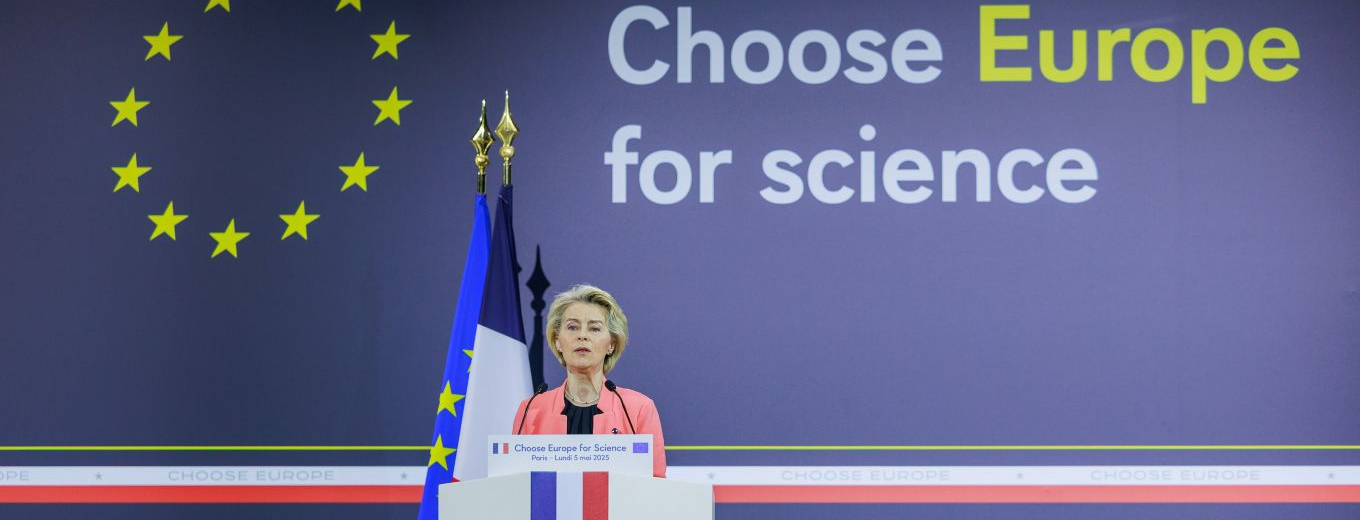The EU adopts a new European research policy agenda for 2025-2027, but the future of the EU’s research funding remains uncertain.
At the famous Sorbonne University in Paris – a venue often used for major speeches on Europe – Presidents Ursula von der Leyen (VDL) and Emmanuel Macron as well as Research Commissioner Ekatarina Zaharieva launched a global call to Choose Europe for Science on 5 May 2025. The EU makes this call in the context of growing US pressure on free research and universities. The goal of the initiative is to attract US-based researchers to move to the EU. Concretely, Choose Europe for Science includes the following elements according to VDL’s speech: i. a new seven-year ERC “super grant”, details to be defined, ii. increasing the budget for relocation support to ERC grantees from €1 million to now €2 million, iii. expanding the MSCA Choose Europe pilot, a new co-funding scheme, and iv. enshrining the freedom of scientific research into EU law via the ERA Act. The European Commission will make €500 million available for the ERC and MSCA elements of the initiative for the period 2025-2027. In contrast, the Swiss government and stakeholders have not set up any special measures to attract US-based researchers to the country and its leading research institutions.
Meanwhile, the controversial discussions on the potential structure of the new European Competitiveness Fund and the next framework programme for research and innovation FP10 (see SwissCore article) took another turn this month. While there were a number of leaks and a lot of speculation, Commission President von der Leyen gave a positive but also confusing public statement on this topic at the EU budget conference on 20 May 2025. She confirmed that “our framework programme Horizon Europe will stay as a self-standing programme. It is an outstanding brand – the most renowned research programme worldwide. But it will be tightly connected to our Competitiveness Fund”. Many research and innovation stakeholders in Brussels have been advocating for FP10 to remain a standalone programme and therefore VDL’s mention of the keyword ‘standalone’ in relation to FP10 was perceived with some enthusiasm. At the same time, it remains to be seen what the Competitiveness Fund will look like and what “tightly connected” means concretely. Answers are expected in July 2025 when the proposal for the next MFF should be presented. On 7 May 2025, the European Parliament once again weighed in on the discussion by adopting a resolution which calls for a “significantly more ambitious MFF” and also “considers the competitiveness fund – which would merge several existing programmes – to be inadequate”. This is noteworthy as it comes from MEPs in the budget committee, supporting the position of the ITRE committee in charge of research and innovation.
On the Council side, the education ministers met on 12 May to discuss the impact of online disinformation and the Commission is planning to prepare an action plan against cyberbullying in 2026. The ministers also adopted a Council recommendation on a European quality assurance and recognition system for higher education and a resolution on a joint European degree label and the next steps towards a possible joint European degree. While the idea of a European degree (label) is carried forward and the EU Member States support the progressive preparation for the rollout of the label, the timeline seems to have lost some of the Commission’s ambition; a roadmap proposes three phases of the rollout to be carried out by 2029, after which further steps would be considered and decided on. Later in the month, on 23 May, the research ministers met to discuss the mid-term evaluation of Horizon Europe. They further adopted Council conclusions on the use of AI in science to boost its uptake but also to promote an ethical, sustainable, inclusive and human-centric approach. Finally, the ministers approved the next ERA Policy Agenda 2025-2027 after a long preparatory phase. The new agenda includes 8 ERA actions and 11 more long term structural policies on topics ranging from enhancing research security to boosting the free movement of researchers and data. The Policy Agenda will be complemented for the first time by an ERA Act, a legally binding text, expected for 2026.

